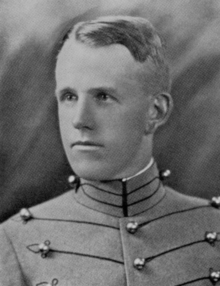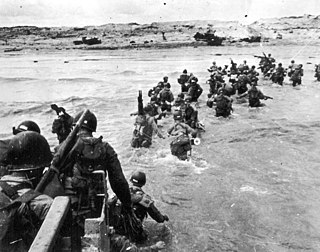
Utah, commonly known as Utah Beach, was the code name for one of the five sectors of the Allied invasion of German-occupied France in the Normandy landings on June 6, 1944 (D-Day), during World War II. The westernmost of the five code-named landing beaches in Normandy, Utah is on the Cotentin Peninsula, west of the mouths of the Douve and Vire rivers. Amphibious landings at Utah were undertaken by United States Army troops, with sea transport, mine sweeping, and a naval bombardment force provided by the United States Navy and Coast Guard as well as elements from the British, Dutch and other Allied navies.

Richard Davis Winters was an American businessman and decorated war veteran who served as an officer in the United States Army during World War II. He is best known for having served with and later commanding Easy Company of the 2nd Battalion, 506th Parachute Infantry Regiment, part of the 101st Airborne Division. He received quick promotions during the war, eventually being promoted to major and placed in command of the regiment's 2nd Battalion.

General Sir Richard Nelson "Windy" Gale, was a senior officer in the British Army who served in both world wars. In the First World War he was awarded the Military Cross in 1918 whilst serving as a junior officer in the Machine Gun Corps. During the Second World War he served with 1st Parachute Brigade and then the 6th Airborne Division during the D-Day landings and Operation Tonga in 1944. After the end of the conflict, Gale remained in the army and eventually, in 1958, succeeded Field Marshal The Viscount Montgomery as Deputy Supreme Allied Commander Europe.

The 502nd Infantry Regiment, previously titled the 502nd Parachute Infantry Regiment, is an infantry regiment of the United States Army. The regiment was established shortly after U.S. entry into World War II, and was assigned as a regiment of the 101st Airborne Division, "The Screaming Eagles", one of the most decorated formations of the U.S. Army. The regiment saw substantial action in the European Theater of World War II and was inactivated in 1945, shortly after the end of the war. Reactivating in a new form in 1956, the 502nd Infantry has served in the Vietnam War, the Persian Gulf War, Iraq War, War in Afghanistan, and Operation Inherent Resolve in Iraq. Since 1974, the regiment has been classified as an Air Assault unit. Currently, its 1st and 2nd battalions are active. Both battalions are assigned to the 2nd Brigade Combat Team, 101st Airborne Division.

The 507th Parachute Infantry Regiment, now the 507th Infantry Regiment, is an airborne infantry regiment of the United States Army. The regiment was initially assigned to the 82nd Airborne Division in World War II before transferring to the 17th Airborne Division. Now 1st Battalion, 507th Infantry Regiment is part of the United States Army Infantry School, subordinate to its Airborne and Ranger Training Brigade, responsible for the Army's Basic Airborne School, Jumpmaster School, Pathfinder School, and the "Silver Wings" Command Exhibition Parachute Team.
Colonel Edson Duncan Raff was a United States Army officer and writer of a book on paratroopers. He served as Commanding Officer (CO) of the first American paratroop unit to jump into combat, the 2nd Battalion, 509th Parachute Infantry Regiment, near Oran as part of Operation Torch during World War II. His book, We Jumped to Fight, was based on his experience in that operation and was published in 1944.

Colonel Richard Geoffrey Pine-Coffin, was an officer of the British Army who saw service during the Second World War. He commanded the 3rd Parachute Battalion in North Africa and the 7th Parachute Battalion in Normandy, Belgium and Germany. His troops, amused by the unusual applicability of his family name, referred to him as "Wooden Box".
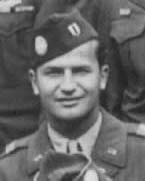
Lieutenant Colonel Ronald Charles Speirs was a United States Army officer who served in the 506th Parachute Infantry Regiment of the 101st Airborne Division during World War II. He was initially assigned as a platoon leader in B Company of the 1st Battalion of the 506th Parachute Infantry Regiment. Speirs was reassigned to D Company of the 2nd Battalion before the invasion of Normandy in June 1944 and later assigned as commander of E Company during an assault on Foy, Belgium, after the siege of Bastogne was broken during the Battle of the Bulge. He finished the war in the European Theater as a captain. Speirs served in the Korean War, as a major commanding a rifle company and as a staff officer. He later became the American governor for Spandau Prison in Berlin. He retired as a lieutenant colonel.

George Madison Jones was a United States Army brigadier general most notable for leading the 503rd Parachute Infantry Regiment in World War II.

Benjamin Hayes "Vandy" Vandervoort was an officer of the United States Army, who fought with distinction in World War II. He was twice awarded the Distinguished Service Cross. He was portrayed by John Wayne in the 1962 war film The Longest Day.

The 501st Infantry Regiment, previously the 501st Parachute Infantry Regiment and 501st Airborne Infantry Regiment, is an airborne forces regiment of the United States Army with a long history, having served in World War II and the Vietnam War, both as part of the 101st Airborne Division, as well as the War in Afghanistan. It is the first airborne unit by designation in the United States Armed Forces. Its 1st Battalion is assigned to the 2nd Infantry Brigade Combat Team (Airborne), 11th Airborne Division, located at Fort Richardson, Alaska. Its 2nd Battalion is assigned to the 1st Brigade Combat Team, 82nd Airborne Division, located at Fort Liberty, North Carolina.

Major General Raymond Oscar "Tubby" Barton was a career officer in the United States Army and combat commander in World War I and World War II. As commander of the 4th Infantry Division during World War II, most notably during the Normandy landings in June 1944, Barton is one of only eleven U.S. Army general officers who commanded their divisions for the duration of their combat service. He commanded the 4th Infantry Division from 3 July 1942 to 26 December 1944 and led them into battle from D-Day at Utah Beach, to the Battle of Normandy, the Liberation of Paris, and into the Battle of Hürtgen Forest before leaving the command due to health problems on December 27, 1944.

John Hersey Michaelis was a United States Army four-star general who served as Commander in Chief, United Nations Command/Commander, United States Forces Korea/Commanding General, Eighth United States Army from 1969 to 1972.

Howard Ravenscroft Johnson was an officer of the United States Army. He was the commander of the 501st Parachute Infantry Regiment during World War II.
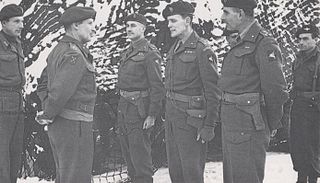
Lieutenant General Sir Napier Crookenden was a British Army General who reached high office in the 1960s.

Major General Roy Ernest Lindquist was a highly decorated senior United States Army officer. He saw service during World War II and is most noted for his leadership of the 508th Parachute Infantry Regiment (PIR) during the campaign in Western Europe from June 1944 to May 1945.

Julian Johnson Ewell was a career United States Army officer who served in World War II, the Korean War and the Vietnam War. He commanded the 9th Infantry Division and II Field Force in Vietnam, and attained the rank of lieutenant general.
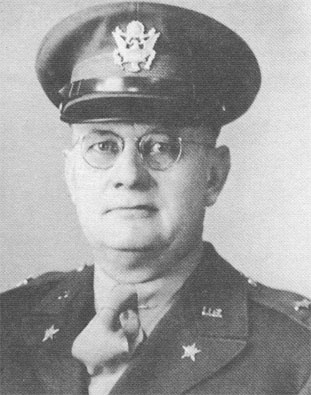
Brigadier General James Edward Wharton was a career United States Army officer who briefly commanded the 28th Infantry Division in the Battle of Normandy before being killed in action during World War II.
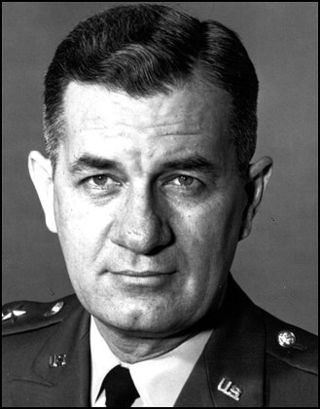
Lieutenant General John Norton was a general in the United States Army. His decorations include the Distinguished Service Medal and the Silver Star. He was key in founding the Army Air Corps and helped pioneer the use of helicopters in combat, and is a member of the Army Aviation Hall of Fame and the Army Field Experimentation Hall of Fame.
Joseph Balkoski is an American military historian and board game designer who has authored eight books on American involvement in the European Theater in World War II, including a five-volume series on the history of the 29th Infantry Division in World War II and a two-volume set on American participation in the D-Day invasion.
